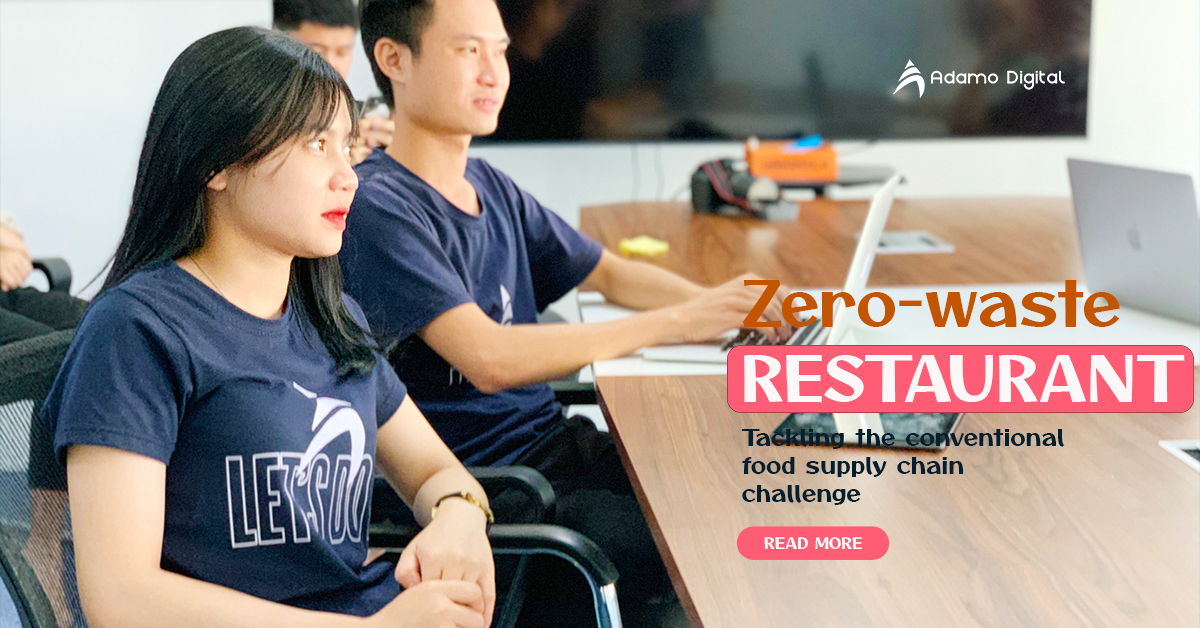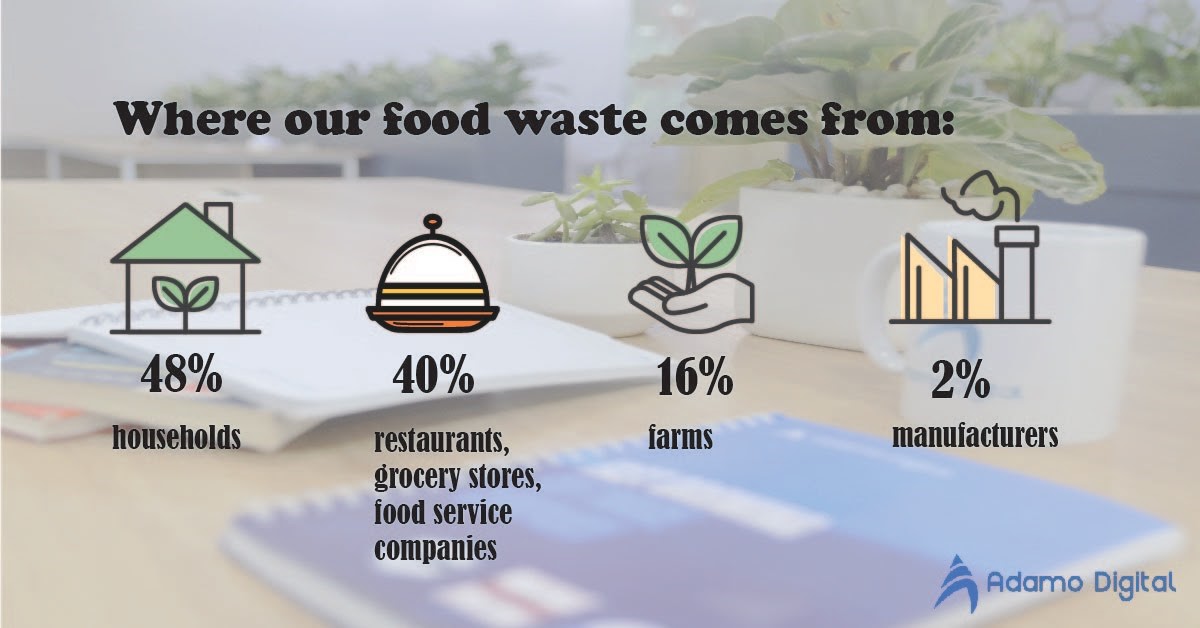Zero-waste restaurant: Tackling the conventional food supply chain challenge

Modern food establishments are trying to attempt to do something with food waste, that’s why the trend of zero-waste restaurant has increased.
Restaurants have used buzzwords such as “locally sourced”, “nose to tail”, or “farm-to-table” to describe and present their missions. Up to now, a new norm has gained popularity, called “zero-waste restaurant”. The name is quite self-explanatory; however, what makes accomplishment from wasting little to no leftovers at a restaurant is more complicated. Many restaurants using food ordering software during the pandemic make the zero-food waste trend more complex than that.
As restaurants aim to not only be healthier businesses, many of them want to build sustainability for the environment. The food throwaway culture is no longer acceptable in the foodservice industry. So, an increasing number of restaurants would like to turn the tide on the amount of food waste. Let’s dive into the zero-waste restaurant and figure out what makes it became trendy.
The rise of zero-waste restaurants or Zero food waste restaurants
According to ZWIA (Zero-waste International Alliance), zero-waste means all resources utilizing production, consumption, packing, reuse, and materials will be conserved without burning and no discharges to the environment. There are no threats to the land, water, or air. This zero-waste movement aims at the “take, make and waste” method to produce, consume and encourage a more spherical approach to the way people use resources, especially on its most fundamental level. The zero-waste movement pushes economies towards no waste to the ground, incinerators, and the sea.
In fact, the zero-waste movement shows the entire lifecycle of a product/materials, representing unsustainable production and consumption processes. This concept helps to produce less waste in production and consumption. Achieving a genuine zero-waste restaurant is more complex. With restaurants applying food ordering software, the zero-waste movement can be more complicated than ever. If a restaurant wants to be officially certified zero-waste, it must divert about 90% of its resources from rubbish bins and refills. This process requires reducing, reusing, and even recycling a large number of ingredients or other resources.
Furthermore, reducing food insecurity is not enough to inspire people to cut down on food waste. Indeed, money can make something positive to human environmental awareness. Regarding the nonprofit organization Feeding American (Food Waste in American, 2021), Americans waste over $28 billion annually on food. Addressing the increasing issue of food waste leads to efficient solutions that dig deep into the problem.
Many firms offering custom software development services help restaurants to estimate the amount of food waste. So how does our food waste come from, especially in the United States? This answer is more complicated than that. Waste comes first from American households (43%); restaurants, grocery stores, and foodservice firms (40%); farms (16%), and manufacturers (2%) where they produce too much food.

For example, Equinox Restaurant in Washington, D.C., which first opened in 1999, has always been one of the most successful of the establishment pillars. It uses its trash and leftovers to make compost and regrow the same ingredients for daily operations. Besides building a zero-waste restaurant, many dining restaurants seek and use local sources as ingredients. It’ll make a contribution to cultural support thanks to reducing or even cutting down on transportation costs. They can adopt food ordering software (from professional software development companies) supporting the restaurant presenting its menu with locally-sourced dishes, etc.
Tremendous benefits of zero-waste restaurants
The zero-waste restaurant concept benefits so many people and places from households, communities to our planet. They can reduce food waste, the use of packaging and plastics, etc. In some cases, zero-waste movement can work with custom software development firms to create food delivery software via the custom mobile apps within a restaurant, bringing several advantages. Thanks to this custom software solution, they can show menus processed by locally sourced guests.
Reduce food waste as environmental responsibility
The zero-waste restaurant concept helps to reduce large amounts of food waste. The estimations for how much food will be wasted every year are hard to define. By statistics, the world wastes nearly 1.4 billion tons of food every year, so each person should repurpose food leftovers and don’t let food waste.
Diminish the use of plastics and Zero-waste packaging
Zero-waste movement can reduce waste from packaging and providing food containers regarding takeaway boxes. According to the Environmental Protection Agency, over 23% of all rubbish thrown to the grounds is food packing and containers. They can be food-related objects such as single-use plastic bags and materials that are unable to be recycled. Furthermore, much more waste from food packing has led to the pollution of roads and water. Some restaurants can use food ordering software through custom software development services to show digital menus and images to guests while ordering food.
A medication for environmental health
Throwing food induces an enormous amount of resource waste regarding water, land energy, and people. So more and more people go to zero-waste restaurants, which can help to enhance environmental health.
Waste food and leftovers are chief contributors to producing greenhouse gas emissions. Greenhouse gases absorb heat and capture it in the air, leading to global warming. Besides, as food is thrown away in landfills, it will release methane, a greenhouse gas that is even danger than CO2. A study shows that food waste accounts for nearly 8% of greenhouse gas emissions every year. Thereby, less food waste makes fewer emissions in the environment.
The Zero-waste restaurant concept supporting the era of the Zero-waste movement

Zero food waste restaurant principles
The zero-waste restaurant principles go through 3 obligations targeting differently. First of all, producers take responsibility for manufacturing and product design. The community places at the back end of principle, being responsible for consumption and disposal. In the middle, politics connects community and food producers, boosting both environmental and human health. Meanwhile, the political responsibility enforces new laws to promote zero food waste principles.
Hierarchy of zero-waste movement for zero-waste restaurant
The zero-waste movement hierarchy essentially expands the three Rs, including reducing, reusing, and recycling. In which it enhances policy-making, investment, and activity in lowering waste.
_ Rethink: Before processing food, we think of using reused, recycled, and renewable non-toxic materials. It essentially encourages cyclical materials, and producers will take responsibility for the whole process of a product.
_ Reduce: Sustainable buying will support social and environmental concerns, as well as local marketplaces. Besides, it helps to avoid the disposal of products/processed food. Also, it minimizes the numbers and amount of toxicity of materials, whereas scheduling for consuming habits to reduce waste. For example, instead of using plastic food containers, restaurants can use compostable containers, reducing plastics and packaging as much as possible.
_ Reuse: Manufacturers can optimize the number of materials and products via repair, repurposing in various ways, and refurbishment. For instance, restaurants can use online ordering food software introduced by the custom software development company to present menus online for guests.
_ Recycle: People can support and develop existing systems allowing for high-quality materials and recyclables. Moreover, it will build local marketplaces for pick-ups and processing of recyclables. Also, it’s crucial to promote composting at home.
_ Material recovery: Zero-waste movement can be made via material recovery. Food manufacturers will optimize material recovery and only utilize the system of energy recovery operating in biological temperatures and pressures.
_ Residual control: In the next stage of the zero-waste movement, people should be concerned about the residual management of food. Food manufacturers reduce toxic gases and residuals from many materials and even food-making processes, significantly managing and controlling the residuals.
_ Unacceptable: Manufacturers have to discourage the incineration of waste, left-behind items and reduce the use of waste-to-energy systems. Producers remove all toxic residuals from products, materials, and even ingredients. Besides, they should reserve all resources and take advantage of destructive disposal approaches.
Zero-waste food trend to watch: From both the business and social side

Zero-waste restaurant: changing statistics
Wondering how much food do people waste? Research of Food Waste in Americans reports that people waste about 1.4 billion tons of food annually while Americans throw away more than any nation in the world. It’s nearly 40 million tons annually. The figure is estimated to be 30 -40% of the whole US food supply and about 219 pounds of food waste each person. In reality, food accounts for the highest proportion taking up area inside the US grounds.
Before the outbreak of covid-19, there were nearly 35 million people in America suffering from food insecurity, of which there were 10 million children. That figure would increase to 50 million people in 2021, owing to the unemployment and financial crisis from the pandemic. The research continues stating that over 80% of Americans discard food since they misunderstand expiration food labels. Many food ordering software developed by the custom software development service company helps the food service industry for producing more food waste and its plastic food containers.
Zero-waste trend
According to the National Restaurant Association Show (2009), people came to discuss the most significant trends in the foodservice industry and their impacts. Eaters turn out to be coming to restaurants that are concerned about the environment, leftovers, packaging, and nutrition. Besides, food and beverage software firms have developed to enhance the presence of food ordering software for restaurants to deliver food. That can lead to food waste and plastic food containers.
Boosting sustainability in the restaurant industry has brought immense benefits to the environment, economy, and society. Cutting down on food waste is one of the most all-embracing opportunities for your restaurant to improve profitability. When reducing the amount of food waste, restaurants’ bottom line goes up, leading to that your business and customers both wins.
Despite not being the main factor, the zero-waste restaurant concept makes guests and business owners see the impacts of food waste in its images and revenue. Besides, sustainability can be a proper marketing approach to appeal to distinguished customers who prefer sustainability and shared values.
The covid-19 outbreak has fundamentally changed the facet of many restaurants. During this time, employees are working from home, and students are learning remotely. So, ordered food bills surged rapidly. As it comes to sustainability, some restaurants following zero-waste food trends are unsure of how restaurants will apply sustainable practices. However, some of them still continue the zero-waste movement. Business owners can take locally sourced ingredients and materials from family farmers. It’ll make local food suppliers invest in their business, which can make the local supply chain healthier and more efficient.
The zero-waste restaurant tries to adopt the free-waste concept in restaurants by applying sustainable practices via its operations. Here are some ideas for a zero-waste restaurant.
Zero-waste food ideas
_ Use perishable ingredients in small quantities and dry food ingredients in bulk.
_ Utilize every piece of vegetables and fruits that restaurants buy
_ Try to buy ingredients seasonally and locally
_ Offer a small amount of food to reduce leftovers on a plate
_ Install water filters on taps
_ Provide compostable containers for takeaways; encourage guests to bring their own food containers.
_ Recommend guests to order the right amount of food
Zero-waste restaurant concept for packaging
_ Find distributors and food producers that deliver ingredients in reusable containers/zero packagings.
_ Stop providing single-use items regardless of plastic straws and condiment sachets.
_ The print menu on recycling paper or using digital menu via food ordering software
Zero-waste food trend for environment
_ Use organic, biodegradable products/ingredients
_ Utilize refillable food containers
_ Go shopping at local suppliers and avoid air-freighting food
_ Use reusable or compostable tableware items like napkins and cutlery
_ Serve a plant-based menu to reduce your carbon footprint
_ Make a garden to grow vegetables and herbs self-supply
Close thoughts
With its benefits to the environment and society, a zero-waste restaurant has risen in the foodservice industry. The zero-waste movement in the restaurant helps to reduce food waste and support environmental health, leading to reducing greenhouse gases. For encouraging the zero-food waste trend, there are many actions that you can take to reduce the waste regarding using local ingredients, growing for self-supply, etc. Hoping that the article will help you have an overview of zero-waste restaurants, their benefits, and approaches to reduce waste.











